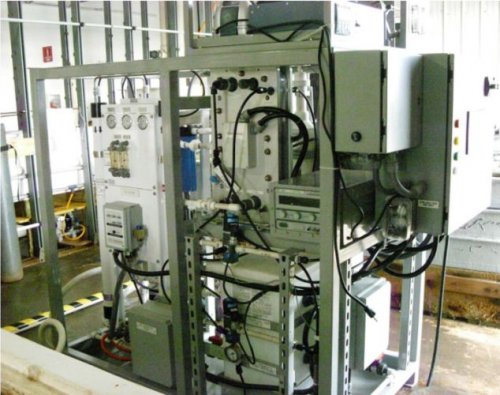seruriermarshal
ACCESS: Top Secret
- Joined
- 4 May 2008
- Messages
- 1,180
- Reaction score
- 574
;D
U.S. Navy creates ‘game-changing’ jet fuel from seawater [VIDEO]
5:59 PM 04/07/2014
The U.S. Navy has developed a new process for generating jet fuel out of ordinary seawater — thanks to technology that could be widely deployed in as little as a decade.
Described as a “game-changer” by officials, the new process extracts carbon dioxide and produces hydrogen gas from seawater, and transforms it into a liquid hydrocarbon fuel thats already been successfully tested in an unmodified two-stroke internal combustion engine.
That means none of the ships making up the Navy’s full fleet will need to be retrofitted or updated to use the fuel.
The Naval Research Laboratory began the project in 2011 and reports it could be commercially viable within seven to 10 years at a stable production cost between $3-6 dollars per gallon.
Without the fluctuating cost of oil prices and shortages or the time-consuming refueling process of meeting oil tankers, Navy ships equipped with the tech could join the nuclear-fueled aircraft carriers and submarines that stay deployed for years at a time.
“We are in very challenging times where we really do have to think in pretty innovative ways to look at how we create energy, how we value energy and how we consume it,” Vice Admiral Philip Cullom said in a Daily Mail report. “‘We need to challenge the results of the assumptions that are the result of the last six decades of constant access to cheap, unlimited amounts of fuel.”
“Basically, we’ve treated energy like air, something that’s always there and that we don’t worry about too much. But the reality is that we do have to worry about it.”
Researchers hope the fuel will also power aircraft, as was demonstrated in the fuel’s first test of a radio-controlled, small scale replica of a WWII P-51 Mustang fighter airplane.
“For the first time we’ve been able to develop a technology to get CO2 and hydrogen from seawater simultaneously – that’s a big breakthrough,” research chemist Dr. Heather Willauer, a 10-year project participant, said.
In the next step toward adoption, researchers will begin working on methods of producing the fuel in mass quantities and partner with several universities to improve the method of extraction to pull even more gases out of seawater.
“Developing a game-changing technology like this, seawater to fuel, really is something that reinvents a lot of the way we can do business when you think about logistics, readiness,” Collum said.
“It’s a huge milestone for us.”
http://dailycaller.com/2014/04/07/u-s-navy-creates-game-changing-jet-fuel-from-seawater-video/
U.S. Navy creates ‘game-changing’ jet fuel from seawater [VIDEO]
5:59 PM 04/07/2014
The U.S. Navy has developed a new process for generating jet fuel out of ordinary seawater — thanks to technology that could be widely deployed in as little as a decade.
Described as a “game-changer” by officials, the new process extracts carbon dioxide and produces hydrogen gas from seawater, and transforms it into a liquid hydrocarbon fuel thats already been successfully tested in an unmodified two-stroke internal combustion engine.
That means none of the ships making up the Navy’s full fleet will need to be retrofitted or updated to use the fuel.
The Naval Research Laboratory began the project in 2011 and reports it could be commercially viable within seven to 10 years at a stable production cost between $3-6 dollars per gallon.
Without the fluctuating cost of oil prices and shortages or the time-consuming refueling process of meeting oil tankers, Navy ships equipped with the tech could join the nuclear-fueled aircraft carriers and submarines that stay deployed for years at a time.
“We are in very challenging times where we really do have to think in pretty innovative ways to look at how we create energy, how we value energy and how we consume it,” Vice Admiral Philip Cullom said in a Daily Mail report. “‘We need to challenge the results of the assumptions that are the result of the last six decades of constant access to cheap, unlimited amounts of fuel.”
“Basically, we’ve treated energy like air, something that’s always there and that we don’t worry about too much. But the reality is that we do have to worry about it.”
Researchers hope the fuel will also power aircraft, as was demonstrated in the fuel’s first test of a radio-controlled, small scale replica of a WWII P-51 Mustang fighter airplane.
“For the first time we’ve been able to develop a technology to get CO2 and hydrogen from seawater simultaneously – that’s a big breakthrough,” research chemist Dr. Heather Willauer, a 10-year project participant, said.
In the next step toward adoption, researchers will begin working on methods of producing the fuel in mass quantities and partner with several universities to improve the method of extraction to pull even more gases out of seawater.
“Developing a game-changing technology like this, seawater to fuel, really is something that reinvents a lot of the way we can do business when you think about logistics, readiness,” Collum said.
“It’s a huge milestone for us.”
http://dailycaller.com/2014/04/07/u-s-navy-creates-game-changing-jet-fuel-from-seawater-video/

